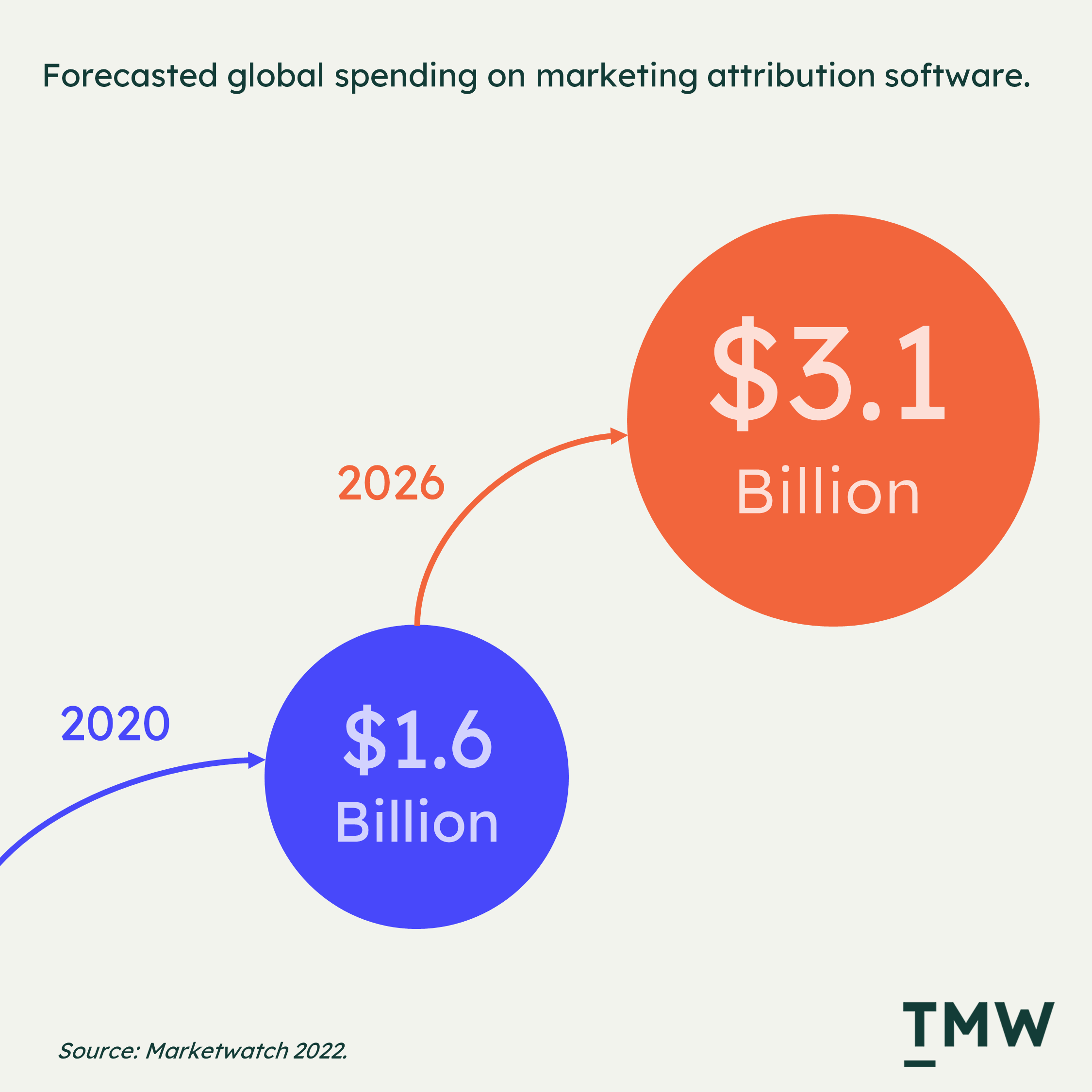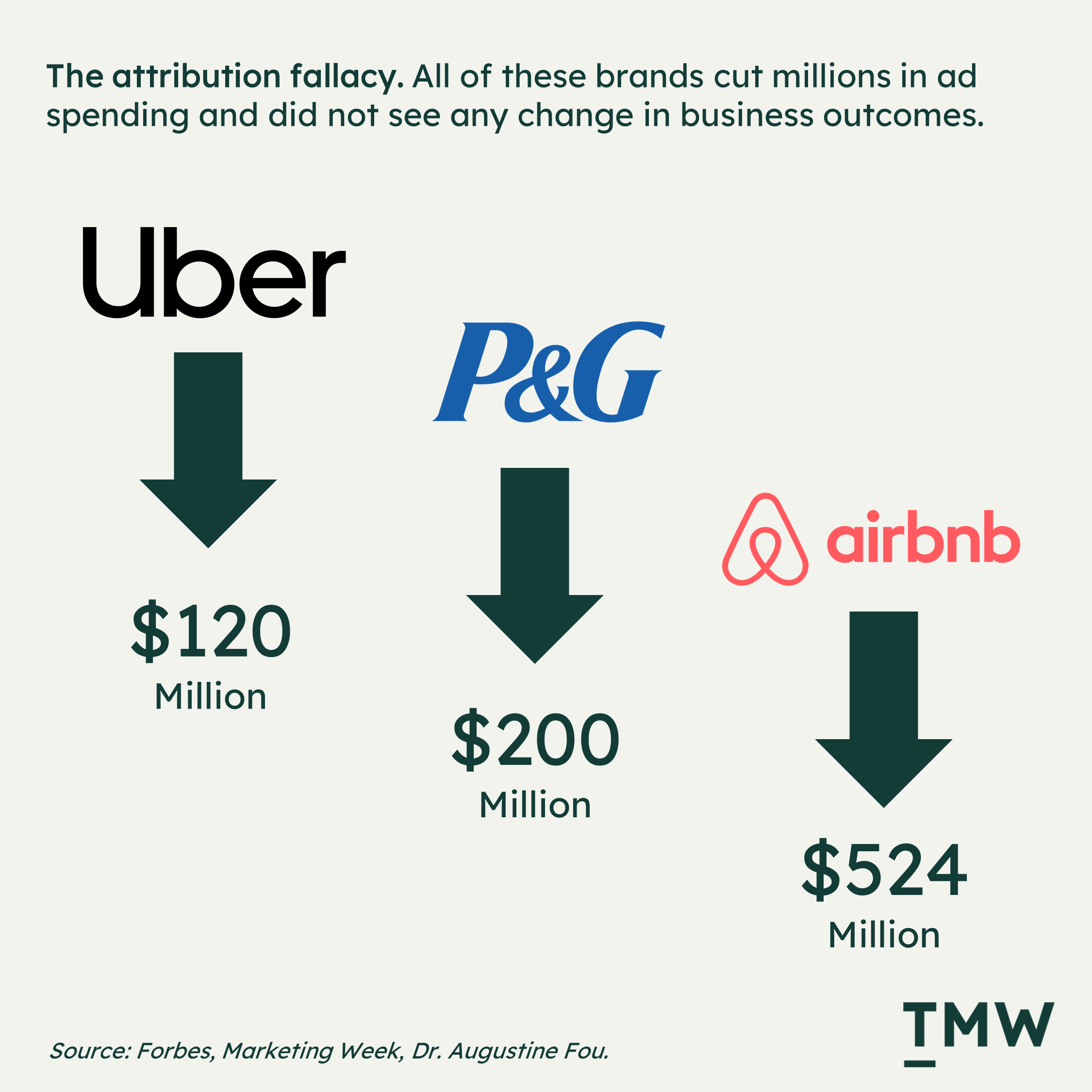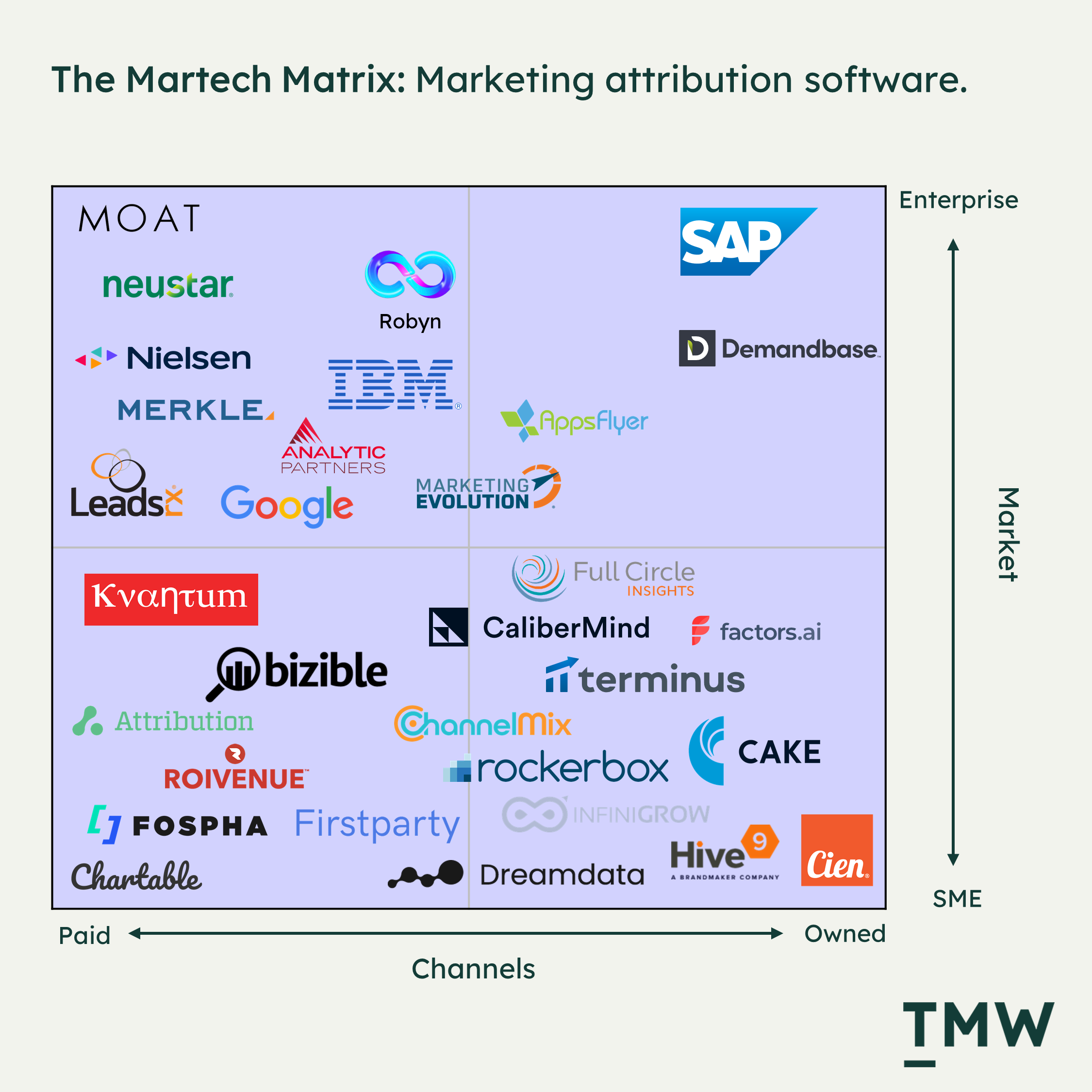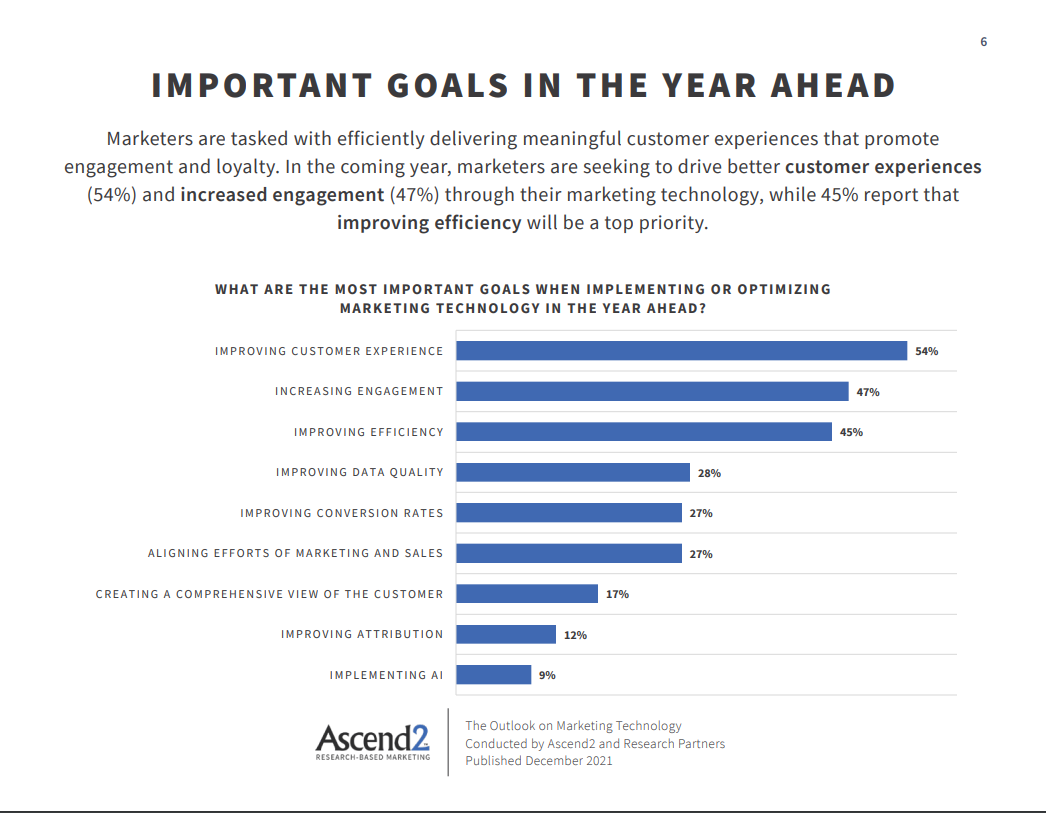TMW #079 | The marketing attribution fantasy, Martech and CX, and explaining your algorithm
Welcome to The Martech Weekly, where every week I review some of the most interesting ideas, research, and latest news. I look to where the industry is going and what you should be paying attention to.
👋 Get TMW every Sunday
TMW is the fastest and easiest way to stay ahead of the Martech industry. Sign up to get the full version delivered every Sunday for this and every TMW, along with an invite to the TMW community. Learn more here.
Here’s the week in Martech:
- The marketing attribution fantasy. Despite our best efforts, most of marketing attribution is still a complete mystery
- The CX and Martech overlap. Most companies use Martech to improve customer experiences
- Explaining your algorithm. EU regulation wants big tech to expose their algorithms
- Everything else: Streaming wars, Substack, content moderation, the state of online creators, creepy personalisation, the CDP of spreadsheets, data factories, and self-destructive AIs
✍ Commentary
The marketing attribution fantasy. I don’t believe that we’ll ever solve the problem of marketing attribution completely. Despite billions of dollars of spending each year on measurement technologies and a deep-seated mindset that everything in marketing must prove a return on investment, most of the time we’re still guessing.
Marketing attribution is a complicated field of Martech. The hope is that if we sort out our analytics, track absolutely everything and apply the magic of machine learning and data science, we’ll somehow have perfect visibility over every single causation and correlation connected to our marketing activities. It’s a noble goal and something that many companies work hard and invest big to get right.
What is attribution? Avinash Kaushik, the marketing attribution mastermind, explains it this way – “Attribution is simply the science (sometimes, wrongly, art) of distributing credit for Conversions.” Forrester explains it like this “the practice of allocating proportional credit to all marketing communications, across all channels, that ultimately lead to the desired customer action.” If you break down what marketers are after with attribution, it’s about answering a fundamental three-word question – did it work?
If you talk to marketing managers, and digital folks they will tell you that for them to attract larger budgets, greater internal authority, and the ability to grow their business, they will need to prove that what they are doing - whether that be running Facebook ads or creating billboards or hiring an influencer – is creating more value than it extracts from a business. Having clarity on this value exchange across channels, content and campaigns is where so much of marketing budgets already go. Marketers everywhere have placed their trust in analytics solutions. By 2026 the spending on marketing attribution software is set to reach beyond $3 billion.

But the hope we have in attribution software has been exactly that, an act of faith for more than 20 years. Somehow, someone, somewhere will create a technology that will solve the hard problem of attribution, and we’re still waiting. The reason we’re still waiting comes down to the problem of aggregation, the inability to collect trustworthy data from the places where it matters, and the untamable chaos of customer behavior.
To make matters more complicated, in the past twelve months alone we’ve seen drastic changes to how marketers traditionally do attribution. Apple’s restrictions on app tracking, coupling with the decommissioning of third-party cookies, and greater international data privacy regulations have caused a titanic shift in how marketers are approaching online advertising measurement. This shift has just begun and we’re only now starting to feel its wake.
Attribution technology is only as valuable as its ability to aggregate complex data points and customer scenarios. No marketer cares if a single person saw a YouTube ad, then searched on Google for a product, clicked through from a sponsored social post, and then purchased. But marketers do care about how many people go through this path to purchase something, and even more, if they can weigh and compare the contribution of YouTube, Google, and social media in that path. The value is in the aggregate.
This is one of the major issues with the promises of attribution – trying to aggregate something that is multi-dimensional in its randomness. Attribution is about taming the chaos with causation and correlation. But what changes if we really can’t measure or categorize the chaos? The problem of aggregation is that with each customer, each trackable interaction is a data point, and stretch those over millions of customers with potentially billions of interactions and then you have a lot of noise to sift through, making even small conclusions hard to justify.
The other reason why we’re still waiting for attribution solutions that work is the obvious flaws in what we can measure. After more than 100 years of marketing and advertising, the internet changed how we think about marketing performance. All of a sudden, we can measure who clicks on something, and what content they consume, and how often they purchase. The digitization of media, commerce and identity gave us powers of measurement beyond our wildest dreams, and the ability to AB test against the data we can collect gave us the ability to draw causative conclusions about the reality of our customers and their experiences.
Despite these tools of innovation, we’re still mostly guessing. Rand Fishkin, the CEO of Spark Toro, and Tim Suolo, the CMO of Ahrefs have both come out with separate analyses of the practice of marketing attribution, and conclude that we really cannot measure all of the offline and online interactions someone has with something they want to purchase, nor can we really infer to what degree a piece of content or an ad influences a customer action.
A few famous studies into attribution suggest that most of the time, even some of the world’s biggest brands are still guessing. Airbnb, Uber, and P&G have withheld hundreds of millions in online advertising spending and saw no change in business outcomes. eBay, way back in 2014 did a joint study with Stanford University on withholding advertising with Google search, and their conclusions were the same. Removing ad spending had no tangible impact on business performance.

The question then becomes, what is driving the business outcomes for these brands, if it’s not online advertising? The promise of attribution is hindered by untrackable blind spots in the customer experience and the ability to aggregate, infer and draw causative conclusions. Even though the question of “did it work?” is a relatively simple one, we might as well be asking if there’s intelligent life in the universe because the answers need an overwhelming amount of investment in science, technology, and innovation to make any progress. For Uber, Airbnb, eBay, and P&G, we may never answer the three-word question.
Maybe, we’re asking the wrong question about marketing attribution, and if so what questions should we be asking instead?
The questions we should ask about attribution are more about the industry we’re working in, than the technology we’re using. A pure-play fashion retailer like Shien, one of the fastest-growing companies in the world is probably not asking how many customers see their billboards, but they are asking about how many video views one of their many recruited influencers is getting on TikTok. P&G is asking questions about footfall in grocery stores, and a company like Salesforce is tracking how many whitepapers downloads they get and how many of them became viable software leads. These are all very different questions that are asked about a small part of the much greater attribution whole.
Multitouch, omnichannel attribution is word salad to sell software. In reality, it’s the smaller areas of a customer’s experience that a business can control which should capture our attention. The parts that have far less control - how many people visit a grocery store or how many cars drive past a billboard, or even how many ad impressions did we get are not really designed to be measured with cause and effect, they are things brands do get into the mind of their consumers.
This is exactly why companies invest so much into brand marketing efforts without asking their agency to justify the return on investment but will ask this question from their AB testing teams. In this way, so much of marketing is a faith-based practice that seeks to create memories in their future customer’s minds. Reach, recall and recognition are all things that matter if you’re managing a massive global brand, and these are all things that you can’t really attribute back to sales or lifetime value.
Mental share and availability cannot be measured and attributed to marketing efforts in a causative way. That’s what we’re missing from this picture. Sure we can run surveys, and approximate what a smaller group says to a whole, but it’s all still theory. Unless we strap a brain scanner to every single one of our customers, we’ll never know what is actually influencing purchasing decisions.
Even Google has come out recently and said that the customer journey is a messy middle, with so many interactions online that it’s impossible to rely on any kind of linear model of measurement. Google is the one company in the world that has the most to lose from data-driven marketing and advertising. This should tell you something about the nature of measurement in marketing. Customers are just too chaotic to track. I have a hard time figuring out what my 2-year-old son is doing most of the time. Asking my older daughter why she does things gives me blank stares in return.
The sooner we realize that more often than not, people do things on random impulses that are hard to explain the faster we’ll put marketing attribution in its right place. After all, companies do things on blind faith all the time, hiring employees and trusting that they will be successful in their role is one obvious example, launching a new brand identity is another. There is no clarity on if our efforts will be successful in most things in business.
This is precisely why brands that get ahead don’t invest in technologies that try to measure everything, they put a lot of effort into the things they have far greater control over. After all, when you get the call that the marketing team is falling behind targets this quarter, doing things that you have far greater control over, things like your website experience, customer service or email marketing is where the focus goes.
Regardless, the desire, and hope of answering the question of “did it work” is the catalyst that organizes hundreds of marketing technology companies around a promise of marketing attribution. From companies that build monolithic ML programs to measure ad spend and ROI from Google analytics offering multi-touch attribution in GA4 and Meta’s open-source marketing mix modeling attribution technology, there’s an entire industry of technologies that continue to iterate around the edges of the “did it work” question.

For those of us who started our careers on digital channels, it might seem impossibly stupid to not try and measure our marketing efforts. But that’s been the norm for hundreds of years and without a doubt will continue to be this way. So far, the marketing industry has made great strides in collecting data and aggregating it so we have a picture of performance. But that picture is just one page of a rather large book, of which the contents, and stories about our customers that live on every other page we’ll never know.
If marketing attribution is about anything, it's about investing in analyzing the things you can control and embracing the mystery of everything you can’t. Links: REFORGE, SPARKTORO, AVINASH, TIM SOULO, FORBES, GOOGLE ATTRIBUTION, EFFICIENCY ERRORS,EBAY CASE STUDY, EHRENBERG-BASS.
📈Chart Of The Week
How Martech and CX overlap. Research from Ascend2 polling marketing technology practitioners suggests that the goals of implementing technology in marketing are largely about improving the customer’s experience and engagement. It’s entirely true to say that Martech is about enabling customer experience in most use cases. So why do we call it Martech and not Custech?

📰 Latest Developments
Explaining your algorithm. The working group that is producing the EU Digital Services Act legislation has announced that technology companies will need to divulge information on how their algorisms work. It’s not detailed to what extent and how technical the information will be, but the enforcement may be the biggest change in legislation historically. The Act will give the EU powers to fine companies up to 6% of their annual turnover that do not comply. Link
News from the streaming front lines. CNN+ the company’s subscription streaming platform for news lasted for a total of 28 days after spending hundreds of millions on content, consultants, and setting up the platform. Netflix also saw its first major decline in users, a drop of 200,000 mostly from limiting password sharing and increased competition. The technology of streaming businesses are no longer a differentiator. Links: BEN EVANS,CNN+
Substack as a network? Substack has announced its first major play into newsletter discoverability by allowing newsletter writers to recommend other newsletters on the sign-up screen. This is not algorithmic, but user-driven, which keeps 99% of unknown writers out of the recommendations of the writers with audiences that will make a difference. The puzzle of content production and distribution from a platform perspective is far from being solved. Substack thinks the solution is creating a popularity contest. Link
📚 Reading
The next vibe shift in web design. An interesting analysis of the DALL E 2 text to image AI program against the context of how web design has changed over time to signal quality and value to consumers. If AIs can generate a million custom illustrations a minute at low to no cost, how will brands signal value? Link Also see my analysis of this tech in TMW #078
Obama on content moderation. Obama gave a speech at Stanford detailing the case for increased content moderation on social platforms and greater alignment with government bodies. How much should social networks facilitate free speech are not tech questions, they are policy and ethics questions. Link
How Adtech folks feel about themselves. With cookie deprecation and every world government thinking seriously about data privacy and online tracking, it must be a very strange time to be working on Adtech. The goalposts of morality in advertising are changing rapidly. Link
🔢 Data & Insights
The state of online creators. Apparently, 5% (~200m) of all social media users are creators who are building and monetizing audiences. Depending on the framing, that’s a big or small number. Link
Online advertising is alive and well. IAB reports the largest single-year increase in global internet advertising revenue since 2006. Spending went up by $50 billion to $189 billion in 2021. The online advertising ecosystem is the gold rush that never runs out of gold. Link
Personalization is creepypasta. A CDP.com survey of 2,500 Americans suggests that AI-powered personalization is attractive, 81% are in favor, but 81% are also concerned about the impacts to online privacy. Link
💡 Ideas
The CDP of spreadsheets. Had a rare moment of “wow” when I saw this app. These don’t come often. Link
The metaverse hype cycle. A framework for understanding what’s going to be pure hype and what will emerge as generation-defining technology in the metaverse category. Link
Data factories, not warehouses. A good argument for why the warehouse is a broken metaphor to describe the data stack. Link
✨ Weird and Wonderful
Self-destructing AIs. Thought experiment: What if you can ask a GPT-3 application to hack its own servers and delete its own code, should the program store a backup of itself? Link
r/Place. A fascinating public art project where thousands of people add artwork to a massive online canvas. Timelapse video shows the scale and diversity of creativity. Link
Coors Light’s slide deck. To minimize the anxiety of seeing your boss in your deck while you’re working on it, Coors provides a slide template to tell your coworkers to chill out and grab a beer. Link
Stay Curious,
Make sense of marketing technology.
Sign up now to get TMW delivered to your inbox every Sunday evening plus an invite to the slack community.
Want to share something interesting or be featured in The Martech Weekly? Drop me a line at juan@themartechweekly.com.
